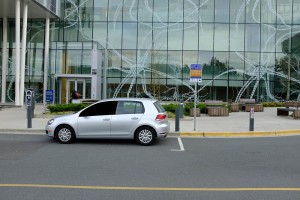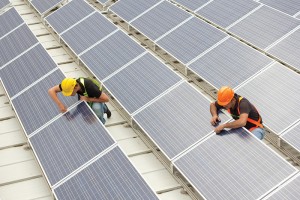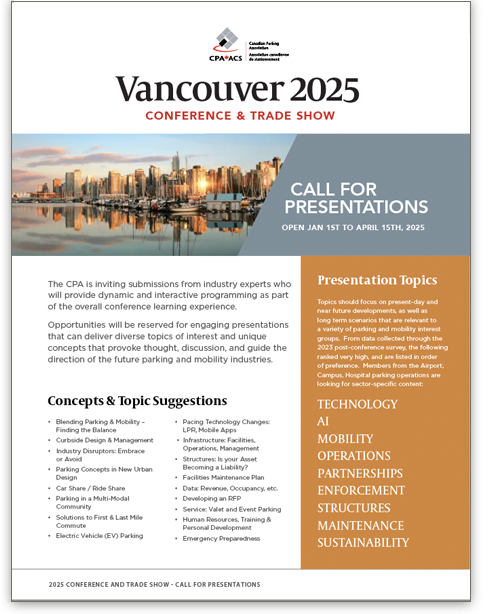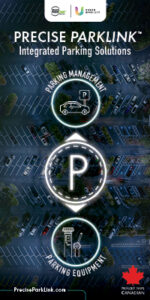By Bill Smith
PHOTO CAPTION: Image shows car above a sensor within the stall and with the signage and meter. This is in front of the Centre for Brain Health (attached to and part of the Hospital)
Single space sensors are one of the most exciting parking technologies to be introduced in recent years. They have quickly gained acceptance throughout the industry because of the many benefits they offer both parkers and parking owners. The most obvious advantage can be found in their parking guidance function. By clearly and accurately indicating where open parking can be found, the sensor technology makes parking more convenient than ever before by eliminating the need for parkers to circle structures and lots looking for an open space. At the same time, the sensors collect data about who is parking in each space and for how long. This is invaluable information for helping owners and operators run their facilities as efficiently as possible.
The University of British Columbia (UBC) in Vancouver has found a new, non-traditional use for this technology. The University recently installed sensors in two areas on campus that have historically had trouble with drivers overstaying permitted parking durations. The areas are intended as drop-off points, but drivers tended to park for extended periods of time, which caused traffic congestion on nearby roadways. The sensors were installed to clearly indicate how long parking was permitted in each space, and encourage compliance with time limits.
UBC’s sensor program utilizes solar-powered Frogparking sensors, which are installed in the ground in each individual space and connected to the university’s parking management grid to provide real-time enforcement and utilization data. Nine sensors were installed at the UBC Hospital Complex and eleven were installed at the recreation center and aquatic centre.
“We began this program last August, and we are already seeing an…
By David Watts
If you drive past the Parking garage at the Ajax GO station, or the Erindale GO station, there is nothing visible that sets them apart from the other dozen or so parking facilities Metrolinx has constructed over the past 2 years.
You must get to the top floor to see the difference – approximately 1,200 solar modules on each of the those roofs, and a purpose built inverter room, designed specifically for the unit that converts the direct current generated by solar modules to the alternating current that powers our houses.
Each garage will generate approximately 342,000 kWH per year, which is the equivalent consumption of 32 or 33 average Ontario homes.
It can also be looked at as offsetting the consumption of the parking facility.
Consumption projections at Erindale showed projected electrical consumption of about 1,000,000 kWH per year. The solar on the roof covers about a third of the annual needs, but if you break it down by season, it covers the summer consumption almost entirely. Winter is another story- the days are shorter and cloudier, and the nights long.
Long term analysis will show us if actual consumption reaches the projected levels, as all the lighting is LED, and lights are on timers and photo-sensors.
How do you plan a solar garage?
It is actually quite simple.
The racking system which connects the solar modules to the building is an engineered, ballasted system. Wind tunnel testing shows us just where we need to place the weight to ensure that the entire array stays put, no matter what nature throws at us.
Typically the universal load for this ranges from 3 PSF to 6 PSF. If the parking facility in the design stage has a top floor that has a minimum extra 7 PSF allowance designed into it, I would call that solar ready….
By Darnel Harris
On January 30, 2013 Richard Florida, the creative class guru published a piece on his CityLab blog entitled, ‘More Losers than Winners in America’s New Economic Geography.’ Effectively distancing himself from the way the theory he popularized for a decade has been implemented, Florida wrote that, “on close inspection, talent clustering provides little in the way of trickle-down benefits. Its benefits flow disproportionately to more highly-skilled knowledge, professional and creative workers whose higher wages and salaries are more than sufficient to cover more expensive housing in these locations. While less-skilled service and blue-collar workers also earn more money in knowledge-based metros, those gains disappear once their higher housing costs are taken into account.” In effect, the ‘creative class’ attracting investments municipalities made were now exacerbating urban inequality, and, were not just, “a vicious cycle but an unsustainable one — economically, politically, and morally.” While Florida has expressed his regret, families continue to swell the ranks of that vicious cycle in North America’s major cities.
Featured in this issue:
- Embryonic Canadian Mobile Payments Market gets Code of Conduct
- Canadian Parking Association Member Profiles
- Green Initiatives: Solar Power Generating Parking Garages
- Who Are You Completing This Street For?
- A Different Look At Single Space Sensors
How Mobility and Social Media Will Change the Industry
By Rachel Levy Sarfin
Technology has changed virtually everything we do, from the way we run our businesses to how we communicate with family and friends. So, it should come as no surprise that it has had an impact on parking. The twin phenomena of social media and mobility have had an especial effect on this space.
Social media and mobility have had an influence on parking in Canada, and Canadians are also using these two forms of technology to improve the way we find parking spots and the way we park. The Canadians profiled in this article are using technology to change the way drivers in Canada and around the world park.
If It’s Not on Facebook, It Isn’t True: Social Media and Parking
Some things have not changed, in spite of technology. If you park well, no one will notice, let alone single you out for praise. On the other hand, a bad parking job would merit you a nasty note on the windshield in the days before social media. In today’s world, you would be lucky just to receive an angry Post-It. More likely, a picture of your vehicle will be posted on popular social networking sites for the entire world to see.
Edmonton residents Daniel Huber and Brian LaBelle have harnessed the power of social media to shame drivers who park terribly. In 2014, restaurateur Huber created a Facebook group called “D-BAG ParkJobs.” The group gives metro Edmonton area drivers the opportunity to upload pictures of poorly parked cars to Facebook and write snarky comments.
Shortly thereafter, his friend LaBelle, a certified child and youth counsellor, decided to start a Twitter account devoted to the same subject. The handle is @DBagParkingYEG. Calgary residents began sending in photos, too. LaBelle then launched Twitter accounts…
By Carolyn Krasnow, Ph.D
In recent years, urban planners and community leaders across Canada have turned to “Smart Growth” planning approaches like Complete Streets and New Urbanism to help communities address common challenges associated with downtown planning in the era of the automobile. After decades of urban design focusing on the primacy of the auto, approaches focus on creating communities and streetscapes that provide, among other things, better integration of multi-modal transportation and better walking environments. The point of these planning approaches is to create healthier, less congested and ultimately more livable communities that also foster economic and commercial development.
Arising in the U.S. but quickly becoming international movements, Smart Growth-influenced developments and streetscape upgrades have cropped up throughout Canada. Canadian cities including Mont-Saint-Hilaire in Quebec, Whitehorse in Yukon, and Markham, Ontario have made their communities more walkable and bicycle-friendly, and improved the quality of life for residents. UniverCity in British Columbia and McKenzie Towne in Calgary were created as new communities with sustainable and/or new urbanist principles.
Creating urban environments that have a better balance of transportation modes isn’t as easy as it sounds. Critics of New Urbanism contend that it still accommodates “car culture” more than is desirable, and many people would like to see greatly reduced parking requirements for new developments and cities alike. And given the aging population, decreasing car ownerships trends among younger people, and the rise of car sharing, there is plenty of reason to plan parking with reduced needs in mind. But on the flip side, in most places cars are still the primary form of transportation for most people; not taking them into account adequately can hurt existing businesses and new ones.
A developer we worked with on a transit-oriented development in a vibrant Canadian city came up against this problem as they planned their…
By Ben Smith, B.E.Env
Multi-story parking lots are unique buildings, one in which all elements of the structure are normally exposed to the public. These structures face unique challenges as well as exposure to niche stresses as well as physical and chemical abuse.
Although often underestimated, the correct specification of waterproofing and surfacing materials is critical, within parking environments, to delivering a long-term, structurally protected and safe facility for parking operators and vehicle owners.
The most suitable deck coating material will largely depend on where within the multi-level or underground parking facility they are to be installed as well as the conditions to which the material will be subjected.
This can range from slip-resistance, durability and service life requirements through to temperature cycling, UV exposure and any problematic existing substrate conditions as well as any anticipated movement within the structure.
Parking has become a vital part of today’s mobile world with more vehicles on the road than ever before. As a result, the demand for parking is at an all-time high with vehicle owners searching for secure and safe environments to house their vehicles when they are without them.
The parking lot is often the first point of call for a visitor to any public, private or commercial venue. It is the “front door” of the building, while at the same time serving its primary functional role. There is no doubt that initial appearance, ease of use, signage, bright lighting and clear directional marking all help to make a parking development a more positive and safer environment.
As new build multi-story and underground parking structures are more frequently adorning the urban landscape so too are older structures being renovated to meet both modern design and safety requirements.
One critical design consideration is the deck coating material chosen to protect the reinforced concrete structure, in order to protect…
By Sharon Lewinson
Cities across North America now recognize the indisputable connection between health and the built environment. Change is happening, the pieces are coming together… but we can do more. And, specific to this article, people in the parking industry need to be involved active participants in the movement towards integrated sustainable mobility.
Parking – a connected piece of the integrated mobility solution
Over the years ACT Canada has delivered annual inspiring Summits on sustainable mobility – showcasing examples of leading policy changes, TDM strategies, programs, innovations and collaborative efforts to increase the use of sustainable travel options. Since the inception of ACT Canada almost 15 years ago, the Canadian Parking Association (CPA) has been a strategic ACT Canada partner, recognizing even back then, the critical role of parking in the integrated sustainable mobility puzzle. Each year CPA takes on a key and visible role in the Summit helping to address and raise awareness of parking related factors influencing urban mobility.
This year ACT Canada will be delivering Canada’s first ever integrated transportation – health focused summit, Sustainable Mobility & Healthy Communities Summit to accelerate the health-driven shift away from car-first communities toward a new emphasis on walking, cycling, public transit, ridesharing and efficient car use. We’re at a ground-breaking pivot point in addressing sustainable mobility and we need parking industry stakeholders at the table.
ACT Canada’s sustainable mobility wheel includes parking in many segments and understanding how and where parking fits might better influence increased engagement by parking stakeholders. Here are just a few examples of how critical parking is to the sustainable mobility equation, and how it impacts each and every segment of the sustainable mobility wheel.
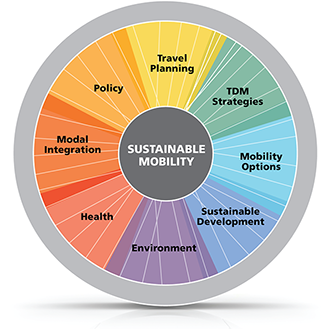
TRAVEL PLANNING
TDM tools, resources, strategies and outreach initiatives typically focus on workplaces, schools or neighbourhoods. Employer organizations…
By Sharon Lewinson
A glimpse into what is happening now & what the future may hold for Accelerating Innovative Parking Strategies
Online rideshare matching started out over ten years ago as a mechanism to help people find carpool partners. They were launched by a few of the most forward thinking municipalities and private sector companies to help their residents or employees choose an alternative to driving alone.
Fast forward a decade and everything has changed. The internet and associated rapid technology advances, along with private and public sector demand (mostly south of the border), have resulted in a few of these systems being fully integrated multimodal transportation portals – and they include parking!
Streamlined integration with a multimodal focus are the fundamental elements that have resulted in the increased effectiveness of these rideshare systems and their growing use worldwide. Understanding how parking stakeholders can use or integrate with this technology can be a vital business strategy for parking organizations. A glimpse into the state of rideshare technology today and where it’s going might help you with your business decisions or open up opportunities for collaboration and engagement with other transportation stakeholders.
What are the high level components included in an online rideshare system today?
While there are many hosted rideshare systems on the market, there are really only a very small few who can provide the enterprise level services demanded from cities and organizations today.
Multimodal systems include matching for not only carpools, but for bike, walking and transit buddies. They include online transit, bike and walking planners, links to transportation agencies, park & ride lots, shuttle routes, EV charging stations, carpool parking and more. They can be the key online resource offered to the public or employees for transportation or commuting information.
Other key attributes:
- In general the core functionality of rideshare matching is also available in…
By Bern Grush, VP Innovation, PayBySky
Any municipality wishing to manage parking access in its commercial district(s) usually considers the parking meter as a management mechanism. This is almost always an uneasy solution—especially for small to mid-sized municipalities—and has been so for 80 years. Established digital technology provides a new way out for such municipalities—flexible, friendly, voluntary and free to shoppers.
In several publications predating 1927, support for parking restrictions were voiced “by some downtown businessman and property owners, who feared that traffic congestion, for which they thought the parked car was largely to blame, raised the cost of doing business and reduced the volume of business done.”1
Not long after, in 1935, the mechanical parking meter was invented to address this. While deployment spread rapidly, the parking meter has always had more enemies than friends and continues to draw ire from both parkers and merchants.
Smaller cities like Huntsville, Sarasota, Springfield, and Windsor, with populations ranging from 20,000 to 210,000, have meters going in and out as downtown merchants who compete with others on the outskirts see parking meters as a threat.
Huntsville, Ontario
In the spring of 2012 Huntsville replaced all parking meters in the downtown core with “signage…posted in certain downtown areas, limiting parking to no more than a two-hour period.”
According to an article in a local paper,2 the backstory for the Huntsville decision is that its town council had decided a few months earlier to “expand paid parking in the downtown core”. This “met with opposition from argued pay parking and parking tickets create animosity among downtown patrons as well as a competitive disadvantage when compared to other commercial areas in the municipality”. The mayor and council offered two alternatives: full authority over the policing of downtown parking, or replacement of the meters with 2-hour free parking. Characteristically,…


